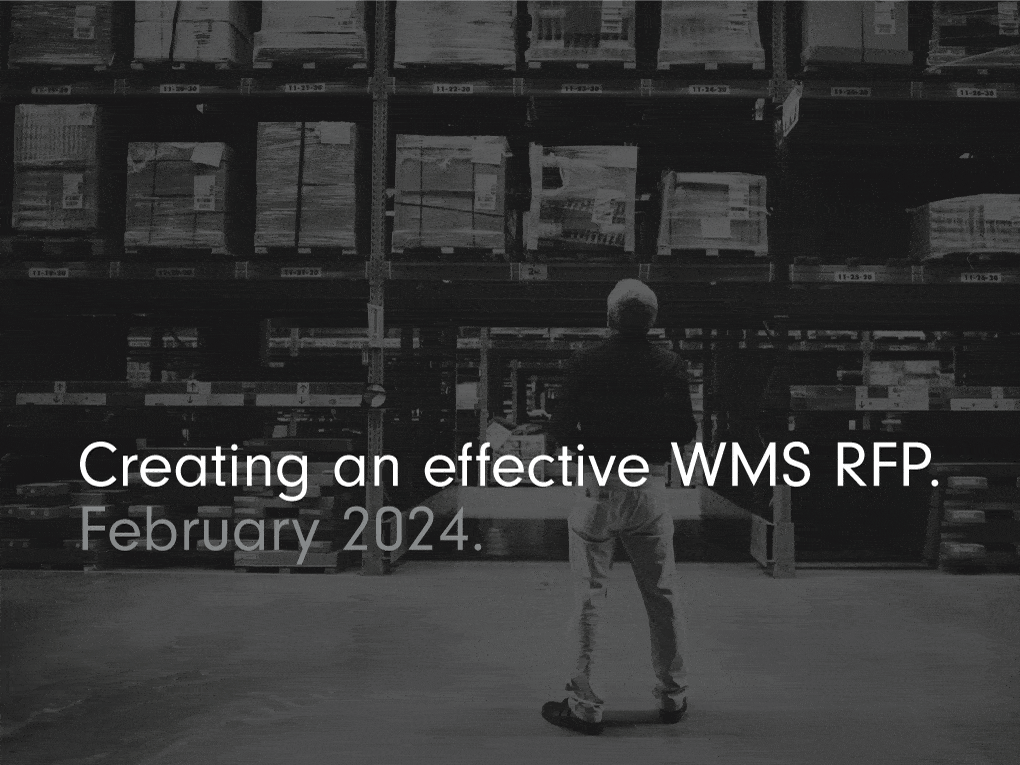Creating an effective warehouse management system (WMS) RFP.

Choosing the right Warehouse Management System (WMS) is critical, as it serves as the backbone of your warehouse operations.
Using a WMS RFP can help you select the right system. It ensures you choose supply chain management software that will bring greater efficiency, productivity and profitability to your warehouse operations.
But getting the WMS RFP right is crucial. There is a big difference between a well-structured WMS RFP and a hastily prepared or ill-conceived one. A high quality RFP will help you find a WMS solution that fits like a glove, whereas a poor one will result in a system that fails to meet your needs, wasting both your time and your resources.
Here we help you understand what an RFP is and the role it has in selecting a WMS. We guide you through creating an effective WMS RFP document that clearly and comprehensively details your requirements.
Plus, take advantage of our free WMS RFP template. It’s been designed to streamline your RFP writing process and ensures you cover all the essentials, saving you the effort of preparing your own RFP from scratch.
What is an RFP?

An RFP – or ‘Request for Proposal’ – is a document that a company sends to vendors. It details the company’s functional requirements for a high value purchase, such as a software system. Receipt of the RFP acts as a formal invitation from the company to the vendor, requesting them to provide a proposal in return.
Companies looking to replace their existing systems typically send their RFP to several vendors. It is fairly standard to cut down a long list of potential suppliers by reducing it to a shortlist, from which the ultimate choice is made.
An RFP differs from some other common requests. These are formal requests that might form part of your procurement process:
- RFI – a Request for Information about the vendor company. This can be used to ascertain if the company can undertake your particular project and allows you to compare certain factors against other suppliers, for example, how many employees the company has, which software solutions they provide, and so on.
- RFT – a Request for Tender is most commonly used in the public sector and is an invitation to bid for a project that has very specific criteria. The tendering process is often public, so can involve rules that strictly govern it and ensure fair competition.
- RFS – a Request for Solution is similar to an RFP but differs in that it allows the vendor more scope to provide an innovative solution rather than responding strictly to the features requirements within an RFP.
- RFQ – a Request for Quote is a request for pricing details for the project if pricing information has not already been included in an RFS, RFT or RFP, or if the specifications have subsequently changed.
The role of an RFP in WMS selection.

It’s vital to choose a WMS that suits your operation, one that will enhance productivity and efficiency within your warehouse.
A WMS RFP helps you to document your precise needs. It’s your chance to outline your functional, technical and operational requirements, so that vendor companies can understand how you work and what it is you expect from the system. Make sure you are crystal clear about what you need so you don’t end up paying for extras you won’t use. Be clear about which features are essential and which may be desirable but not vital, as well as those that you anticipate requiring in the future.
Through the WMS RFP process you can gauge whether the solution offers value for money. By comparing proposals, you can assess which vendor is offering the best price considering not only cost but also the quality and scope of the proposed WMS solution.
Going through a WMS RFP process forces you to systematically evaluate each proposed solution to make sure it lines up with what you’re looking for. Don’t forget to include factors such as the scalability, integration capabilities and future-proofing of each WMS. A WMS that will grow and adapt with your business will better support your long-term operational goals.
By using RFPs, you create a process that allows you to choose the WMS software and vendor fairly. Since each potential supplier is given the same information and is evaluated against the same criteria, you eliminate any bias and are assured of selecting the best vendor based only on merit and fit.
The structured approach of the RFP process helps you to identify and mitigate risks early on in the selection process. Because it requires that you thoroughly vet the potential systems and vendors, it helps you avoid costly mistakes. With such a stringent process, you’re less likely to invest in a WMS that does not meet your needs or to partner with a vendor that cannot provide you with adequate support.
How to structure an effective WMS RFP.

Your warehouse management system RFP should provide detailed information about your warehouse’s needs. These are unique to your company, so you must take the time to define your specific requirements.
These are the key components of an effective WMS RFP
Executive summary.
Give a brief overview of your company, its warehouse operations and the purpose of your RFP.
Company background and objectives.
Provide a company profile that includes information on the size, structure and nature of your business. Outline your general warehouse management needs, the strategic objectives for the WMS implementation, your current challenges and your desired improvements. Detail the key project timelines and milestones for the WMS RFP process, the decision-making and the project implementation.
Scope of work and WMS functionality requirements.
This section will make up the largest part of your RFP. The features outlines here enable potential vendors to gain a deep understanding of your warehouse operations.
We recommend dividing your requirements into the following key categories:
Functional requirements

The journey to voice-enabled picking requires careful planning and consideration.
Selection of Voice Picking Solutions.
Select a system that aligns with your current infrastructure and future growth. Compatibility with your Warehouse Management System (WMS) is crucial for seamless integration.
Integration with Warehouse Management Systems (WMS).
Here are some top-level categories to consider:
- Scheduling
- Inspection
- Receiving
- Put-away
- Allocations management
- Wave management
- Picking
- Kitting / value added services
- Pack and ship
- Inventory management
- Document imaging
- Labour management
- 3PL support
Technical and solution-specific requirements.

Here you can detail your own requirements as well as ask the suppliers about their offering. These are some areas to consider:
- Implementation
- Technology platform and system requirements
- Integration
- Upgrades and product release schedules
- Extensibility
- Customisation
- Reports, dashboards and alerts
Hardware support and integration.
Check which hardware and automation solutions are supported by the proposed WMS, or which can be integrated with it. Here are some suggestions:
- Voice devices
- Pick to light
- Radio frequency (RF) scanners and mobile devices
- Autonomous mobile robots (AMRs)
Vendor qualifications and experience.
Detail your vendor selection criteria here, focusing on their industry experience, project similarity, and technical expertise. You will want to know how experienced they are in your industry and if they have completed projects similar to yours. You should question their technical expertise, WMS software development capabilities and support and training offerings. Consider these aspects:
- General company information and financials
- Training
- Support and maintenance
- Customer involvement and user groups
By following this framework, you will be able to clearly convey your unique requirements. It enables you to manage a thorough selection process that will help you find the WMS solution that aligns perfectly with your warehouse operations and meets your business needs and objectives.
Free WMS RFP template.
Creating a detailed WMS RFP will take time and effort. Leverage our expertise instead of investing your valuable resources in this process. We have prepared a comprehensive WMS RFP template built on observations and best practices from thousands of WMS implementations.
You can use it as is or, for even better results, tailor it more closely to your individual warehouse processes.
Download the free WMS RFP template today to get started.